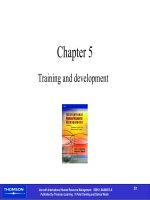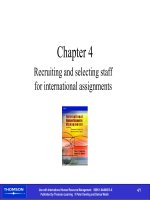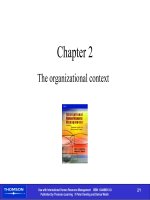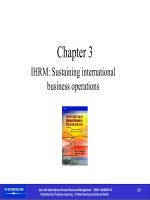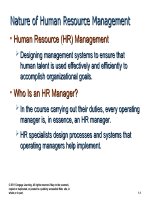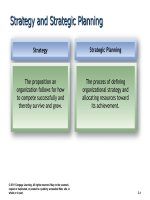Ch07 international human resource management cengage
Bạn đang xem bản rút gọn của tài liệu. Xem và tải ngay bản đầy đủ của tài liệu tại đây (795.66 KB, 20 trang )
Selection and Placement
• Selection
The process of choosing individuals with
qualifications needed to fill jobs in an organization.
Organizations need qualified employees to succeed.
“Hire
hard, manage easy.”
“Good
training will not make up for bad selection.”
• Placement
Fitting a person to the right job.
© 2011 Cengage Learning. All rights reserved. May not be scanned,
copied or duplicated, or posted to a publicly accessible Web site, in
whole or in part.
7–1
Applicant Knowledge, Skills, and Abilities
• Person-Job Fit
Matching the knowledge, skills and abilities (KSAs) of
people to the characteristics of jobs (tasks, duties and
responsibilities–TDRs).
Benefits of person-job fit:
Higher employee performance
Lower turnover and absenteeism
• Person-Organization Fit
The congruence between individuals and
organizational factors.
KSAs = TDRs = Job Success?
© 2011 Cengage Learning. All rights reserved. May not be scanned,
copied or duplicated, or posted to a publicly accessible Web site, in
whole or in part.
7–2
Person/Job Fit Mismatches
Skills/job
qualifications
Geography/
job location
Mismatch
Situations
Earnings/
expectation
s
Time/amoun
t of work
Work/family
© 2011 Cengage Learning. All rights reserved. May not be scanned,
copied or duplicated, or posted to a publicly accessible Web site, in
whole or in part.
7–3
Criteria, Predictors, and Job Performance
• Selection Criterion
A characteristic that a person must have to successfully
perform work.
• Predictors of Selection Criteria
Measurable or visible indicators of selection criteria.
• Validity
The correlation between a predictor and job performance.
• Reliability
The extent to which a predictor repeatedly produces the same
results over time.
© 2011 Cengage Learning. All rights reserved. May not be scanned,
copied or duplicated, or posted to a publicly accessible Web site, in
whole or in part.
7–4
Validity
• Correlation Coefficient
Is an index number that gives the relationship
between a predictor variable and a criterion variable.
• Concurrent Validity
Is measured when an employer tests current
employees and correlates the scores with their
performance ratings.
• Predictive Validity
Measured when test results of applicants are
compared with subsequent job performance.
© 2011 Cengage Learning. All rights reserved. May not be scanned,
copied or duplicated, or posted to a publicly accessible Web site, in
whole or in part.
7–5
Combining Predictors
• Multiple Hurdles
Establishing a minimum cutoff (level of performance)
for each predictor, and requiring that each applicant
must score at least the minimum on each predictor to
be considered for hiring.
• Compensatory Approach
Scores on all predictors are added together, allowing
a higher score on one predictor to offset a lower score
on another predictor.
© 2011 Cengage Learning. All rights reserved. May not be scanned,
copied or duplicated, or posted to a publicly accessible Web site, in
whole or in part.
7–6
FIGURE 7–4
Selection Process
Flowchart
© 2011 Cengage Learning. All rights reserved. May not be scanned,
copied or duplicated, or posted to a publicly accessible Web site, in
whole or in part.
7–7
Applicant Job Interest
• Realistic Job Preview
The process through which a job applicant receives
an accurate picture of the job.
Prevents the development of unrealistic job
expectations in new employees.
Helps avoid truth-in-hiring lawsuits
© 2011 Cengage Learning. All rights reserved. May not be scanned,
copied or duplicated, or posted to a publicly accessible Web site, in
whole or in part.
7–8
EEO Considerations and Application Forms
• Applications should not contain illegal (nonjobrelated) questions concerning:
Marital status
Height/weight
Number and ages of dependents
Information on spouse
Date of high school graduation
Contact in case of emergency
© 2011 Cengage Learning. All rights reserved. May not be scanned,
copied or duplicated, or posted to a publicly accessible Web site, in
whole or in part.
7–9
FIGURE 7–6
Big Five Personality
Characteristics
© 2011 Cengage Learning. All rights reserved. May not be scanned,
copied or duplicated, or posted to a publicly accessible Web site, in
whole or in part.
7–10
Selection
Interviewing
Issues
Face
Validity
Interview
Reliability and
Validity
Intra-rater
Reliability
© 2011 Cengage Learning. All rights reserved. May not be scanned,
copied or duplicated, or posted to a publicly accessible Web site, in
whole or in part.
Inter-rater
Reliability
7–11
Structured Interviews
Structured
Interviews
Biographical
Interview
Behavioral
Interview
© 2011 Cengage Learning. All rights reserved. May not be scanned,
copied or duplicated, or posted to a publicly accessible Web site, in
whole or in part.
Competency
Interview
Situational
Interview
7–12
Structured Interviews (cont’d)
Benefits of Structured Interviews
Obtain consistent
information needed
for a selection
decision
Are more reliable and
valid than other
interview formats
© 2011 Cengage Learning. All rights reserved. May not be scanned,
copied or duplicated, or posted to a publicly accessible Web site, in
whole or in part.
Meet federal EEO
guidelines for the
selection process
7–13
Less Structured Interviews
• Nondirective Interview
Questions are developed from the answers to
previous questions.
Possibility of not obtaining needed information.
Information obtained may not be not job-related or
comparable to that obtained from other applicants.
• Stress Interviews
An interview designed to create anxiety and put
pressure on an applicant to see how the person
responds.
© 2011 Cengage Learning. All rights reserved. May not be scanned,
copied or duplicated, or posted to a publicly accessible Web site, in
whole or in part.
7–14
Other Interview Formats
• Panel Interview
Interview in which several interviewers meet with
candidate at the same time.
• Team Interview
Interview in which applicants are interviewed by the
team members with whom they will work.
© 2011 Cengage Learning. All rights reserved. May not be scanned,
copied or duplicated, or posted to a publicly accessible Web site, in
whole or in part.
7–15
Who Conducts Interviews?
Interviewers
Individuals
Individuals
Sequentially
© 2011 Cengage Learning. All rights reserved. May not be scanned,
copied or duplicated, or posted to a publicly accessible Web site, in
whole or in part.
Panel
Interview
Team
Interview
7–16
Effective Interviewing
• Conducting an Effective Interview
Plan the
Interview
Control the
Interview
Use Effective
Questioning
Techniques
• Questions to Avoid:
Yes/No questions
Obvious questions
Questions that rarely produce a true answer
Leading questions
Illegal questions
Questions that are not job related
© 2011 Cengage Learning. All rights reserved. May not be scanned,
copied or duplicated, or posted to a publicly accessible Web site, in
whole or in part.
7–17
FIGURE 7–8
Questions Commonly
Asked in Selection
Interviews
© 2011 Cengage Learning. All rights reserved. May not be scanned,
copied or duplicated, or posted to a publicly accessible Web site, in
whole or in part.
7–18
References
• Questions to Ask:
Dates of employment
Position held
What were the job duties?
What strengths/weaknesses did you observe?
Were there any problems?
Would you rehire?
© 2011 Cengage Learning. All rights reserved. May not be scanned,
copied or duplicated, or posted to a publicly accessible Web site, in
whole or in part.
7–19
Making the Job Offer
• Offer Guidelines
Formalize the offer with a letter to the applicant
clearly stating the terms and conditions of
employment.
Avoid vague, general statements and promises.
Require return of a signed acceptance of the offer.
© 2011 Cengage Learning. All rights reserved. May not be scanned,
copied or duplicated, or posted to a publicly accessible Web site, in
whole or in part.
7–20



